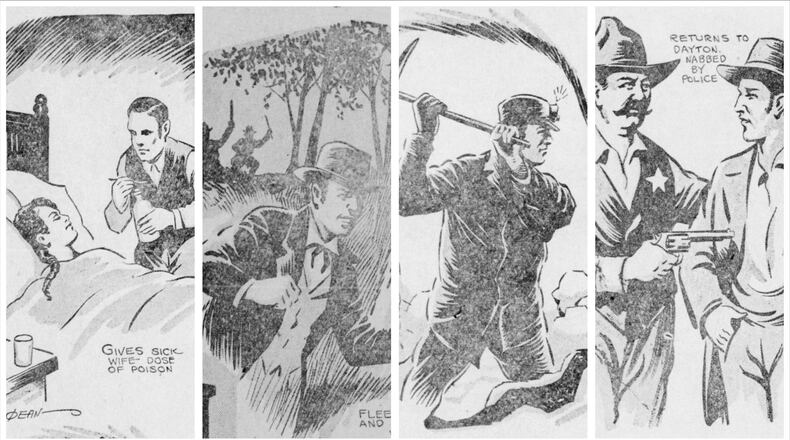It was the first known execution in the Dayton region.
Early life
McAfee was born in Pennsylvania in 1803. His parents died when he was young, and an uncle took him in.
At 18, McAfee ran away from home and headed for the recently opened territory then known as “the Northwest.” His wanderings brought him to Dayton.
About a year later, and when he was 19, he married a daughter of a pioneer Dayton citizen, and for several months they lived happily. Then McAfee started drinking to excess and quickly lost his standing in the community.
Into his life came a new love, a girl by the name of Hetty Shoup, who lived in the home next door to the McAfee’s.
The crime
An account of the murder, reported by the Dayton Daily News in 1930, relayed the following.
On the evening of June 20, 1824, McAfee went home from town to find his wife unable to leave her bed. She had been ill for several weeks, therefore, an easy matter for McAfee to persuade her to drink a poisonous drug (opium) which he had carried home.
But the drug failed to accomplish the purpose intended as quickly as McAfee had hoped for. In desperation he seized his wife by the throat, strangling her to death.
The little settlement of Dayton had not been accustomed to acts of violence, and when the news spread, residents decided to take action. Throughout the night and well into the following day the woods for miles around were searched for a trace of the murderer. The crime became the singular topic of conversation, and each day found the cry for vengeance growing stronger.
Months rolled on without a trace of McAfee. He had escaped to West Virginia, where he worked as a coal miner for some time. Then one day in early fall, McAfee returned. He was recognized, and a few hours later was in the hands of the law.
He was immediately arraigned on a charge of murder, and while he admitted his guilt, he blamed his downfall on Hetty Shoup.
The trial and hanging
McAfee was indicted in November of that year by a grand jury.
A jury was formed and a trial took place in February 1825. McAfee was sentenced to death for the murder by judge Joseph H. Crane.
It was decided not to encourage mob violence by delaying his execution. So a crude scaffold was erected.
The few roads that led into the town were heavy with mud, yet on the day set for the execution, March 23, 1825, whole families labored through this mud in heavy vehicles. Some came from as far as 20 miles away.
Hetty Shoup was among those present. McAfee met death stoically, according to reports. He made no confession on the scaffold.
McAfee was executed by Sheriff George C. Davis. The execution took place near the edge of town, in open air for all to see.
Other known Montgomery County hangings
Col. Charles T. Freeman, bailiff for Judge Roland W. Baggott and former sheriff of the county, provided all known details from executions from that time.
— Francis Dick was the second hanging in Montgomery County, which took place in September 1854.
Dick was executed for the murder of his mother-in-law, Elizabeth Young, and her 16-year-old son, James, in August 1853.
— John W. Dobbins was the third hanging victim in Montgomery County. Dobbins was executed on April 15, 1864, for the murder of a farmer named George Lindemuth on the river bank at the head of Jefferson Street.
The murder occurred on Feb. 14, 1863 and Dobbins used a pocketknife to carry out the crime.
— James Murphy was hanged Aug. 25, 1876. He is the only murderer in the county to be hanged twice. When the trap sprung the first time, the rope broke and it needed to be replaced to rehang the man.
He was charged with the murder of Col. William Dawson, a highly respected citizen and among the best-known residents of the Soldiers’ Home, at a wedding reception near Dayton. Murphy had gone to the dance without invitation and was refused entry by Dawson. Murphy then shot Dawson to death.
Murphy, an Irishman, was said to have danced an Irish jig on the scaffold, entertaining the crowd there to watch, before his death.
— Harry Adams was executed on June 15, 1877 at 1 p.m.
He was charged with killing Henry Mulheimin over money, with a shoemaker’s hammer on or about Feb. 21, 1876. Following a trial, he was found guilty on Dec. 9, 1876.
Several other men from Montgomery County were executed in later years, but those hangings took place at the penitentiary in Columbus.
About the Author




